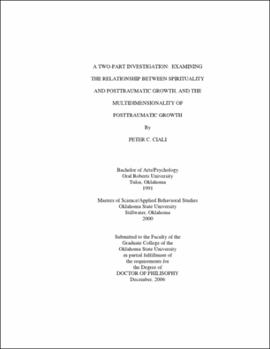| dc.contributor.advisor | Romans, John | |
| dc.contributor.author | Ciali, Peter C. | |
| dc.date.accessioned | 2013-11-26T08:34:19Z | |
| dc.date.available | 2013-11-26T08:34:19Z | |
| dc.date.issued | 2006-12 | |
| dc.identifier.uri | https://hdl.handle.net/11244/7348 | |
| dc.description.abstract | Scope and Method of Study: Posttraumatic growth explains the positive changes that may occur when an individual struggles with a major loss or trauma. Utilizing archival data, the primary purpose of this study was to reexamine the component structure of scores of the Posttraumatic Growth Inventory (PTGI), with a larger sample that was more diverse in age, from Tedeschi and Calhoun's (1996) original validation study. Participants included 1,087 survivors of law enforcement officers who have been killed in the line of duty. The participants were originally recruited through their membership in the national organization of Concerns of Police Survivors (COPS). A second goal of this study was to determine the component structure of scores of the Spiritual Involvement and Beliefs Scale-Revised (SIBS-R; Hatch et al., 2001) with this study's current sample. The final goal of this study was to determine the relationship between each measure in the study, and more specifically to obtain a more in-depth analysis of possible relationships among the underlying factors of PTG (Relating to Others, New Possibilities, Personal Strength, Spiritual Change, Appreciation of Life) and spirituality (Core Spirituality, Spiritual Perspective/Existential, Personal Application/Humility, Acceptance/Insight). | |
| dc.description.abstract | Findings and Conclusions: A forced, five-factor principal component analysis (PCA) revealed a four-factor solution for the 21-item PTGI. Furthermore, a forced, four-factor PCA found a three-factor solution for the SIBS-R. However, after examining each instrument with more conservative factor retention criteria (i.e., Scree plot test), the decision was to interpret a one-factor solution for both the PTGI and SIBS-R. Consequently, a Pearson correlation analysis was performed to measure the relationship between the overall constructs of spirituality and posttraumatic growth. Results from the Pearson correlation analysis found that individuals with more well developed, or stronger spiritual beliefs and practices, did evidence significantly more posttraumatic growth than individuals with less developed spiritual beliefs and practices. The relationship between spirituality and posttraumatic growth was found to be positive, and significant (r = .364, p < .01). Implications for future research are discussed. | |
| dc.format | application/pdf | |
| dc.language | en_US | |
| dc.rights | Copyright is held by the author who has granted the Oklahoma State University Library the non-exclusive right to share this material in its institutional repository. Contact Digital Library Services at lib-dls@okstate.edu or 405-744-9161 for the permission policy on the use, reproduction or distribution of this material. | |
| dc.title | Two-part investigation: Examining the relationship between spirituality and posttraumatic growth, and the multidimensionality of posttraumatic growth | |
| dc.contributor.committeeMember | Bear, Teresa | |
| dc.contributor.committeeMember | Boswell, Don | |
| dc.contributor.committeeMember | Barnes, Laura | |
| osu.filename | Ciali_okstate_0664D_2109.pdf | |
| osu.accesstype | Open Access | |
| dc.type.genre | Dissertation | |
| dc.type.material | Text | |
| thesis.degree.discipline | Educational Psychology | |
| thesis.degree.grantor | Oklahoma State University | |
